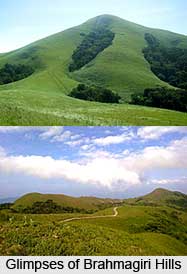 Brahmagiri are a range of mountains situated in the Western Ghats of South India. Brahmagiri is about 200 Kms from Bangalore which is also known as "Silicon Valley of India". The dense forest and wildlife are the attractions of these hills. The temples and trekking facilities of Brahmagiri hills also play key roles in luring tourists from four corners of the world.
Brahmagiri are a range of mountains situated in the Western Ghats of South India. Brahmagiri is about 200 Kms from Bangalore which is also known as "Silicon Valley of India". The dense forest and wildlife are the attractions of these hills. The temples and trekking facilities of Brahmagiri hills also play key roles in luring tourists from four corners of the world.
Etymology of Brahmagiri Hills
The word Brahmagiri literally means mountain peaks covered with fog.
Location of Brahmagiri Hills
The Brahmagiri hills are located at the border between Wayanad district of Kerala on the south and Kodagu district of Karnataka in the north. The hills are situated at an altitude of one thousand six hundred and eight meters above mean sea level.
Religious Significance of Brahmagiri Hills
The hills are home to various temples. On the Kerala side of the Brahmagiri hills, a temple dedicated to Lord Vishnu had been built. The Brahmagiri hills are at a distance of eleven kilometres from Thirunelli. The temple is also known as Dakshina Kasi or the Kasi of South. The temple was designed in an ancient style and comprises of thirty granite pillars. The other old temples and sacred ponds make the hills a popular destination for devotees.
Attractions of Brahmagiri Hills
The peak of the Brahmagiri hills is covered with dense forest which in turn, thrives with abundant wildlife. Besides these, coffee and orange plantations can also be found on the hilly slopes. Brahmagiri hills offer a number of sightseeing spots as well. For instance, Pakshipathalam is situated at an elevation of 1740 meters. It is an attraction in the Kerala part of Brahmagiri where there is an ancient cave. The Karnataka side of the cave is known as Munikal cave. The Iruppu Falls of the Lakshmana Tirtha River lies in the Karnataka part of Brahmagiri. It is a major attraction and is a thrilling experience for travellers.
Trekking at Brahmagiri Hills
Brahmagiri hills are suitable for trekking. The trekking can be started from Mananthavady (29 km east) or from Kutta. From Karnataka side, trek to Brahmagiri from Irupu Falls is around nine km and to Munikal Caves is seven km. However to start the journey, the trekkers need to take permission from Range Forest Officer at Srimangala.















